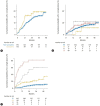Impacts of muscle mass dynamics on prognosis of outpatients with cirrhosis
- PMID: 36117443
- PMCID: PMC9597226
- DOI: 10.3350/cmh.2022.0231
Impacts of muscle mass dynamics on prognosis of outpatients with cirrhosis
Abstract
Background/aims: Sarcopenia negatively affects the prognosis of cirrhotic patients, but clinical implications of changes in muscle mass remain unclear. We aimed to elucidate its role in the prognosis of outpatients with cirrhosis.
Methods: Patients with cirrhosis who underwent annual abdominal computed tomography (CT) for hepatocellular carcinoma surveillance were included in the prospective cohort. The L3 skeletal muscle index (SMI) was adopted as a proxy for the amount of skeletal muscle, and the rate of SMI change between inclusion and after 1 year (ΔSMI/yr%) was calculated.
Results: In total, 595 patients underwent a second CT after 1 year. Among them, 109 and 64 patients had sarcopenia and Child-Pugh class B/C decompensation at inclusion, which changed to 103 and 45 at the 1-year follow-up, respectively. During a median follow-up of 30.1 months after 1 year, 86 patients had at least one cirrhosis complication, and 18 died or received liver transplantation. In the development of cirrhosis complications, ΔSMI/yr% was independently associated, even after adjusting for the Child-Pugh and model for end stage liver disease (MELD)-Na scores. In addition, ΔSMI/yr% showed a good predictive performance for the development of cirrhosis complications within 6 months after 1-year follow-up in all subgroups, with a cut-off of -2.62 (sensitivity, 83.9%; specificity, 74.5%) in the overall population. SMI at 1-year and Child-Pugh score were independent factors associated with survival. In addition, changes in sarcopenia status significantly stratified survival.
Conclusion: ΔSMI/yr% was a good predictor of the development of cirrhosis complications in outpatients with cirrhosis, independent of Child-Pugh and MELD scores.
Keywords: Liver cirrhosis; Prognosis; Sarcopenia; Survival.
Conflict of interest statement
The authors have no conflicts to disclose.
Figures





Similar articles
-
Sarcopenia as a prognostic predictor of liver cirrhosis: a multicentre study in China.J Cachexia Sarcopenia Muscle. 2021 Dec;12(6):1948-1958. doi: 10.1002/jcsm.12797. Epub 2021 Sep 14. J Cachexia Sarcopenia Muscle. 2021. PMID: 34520115 Free PMC article.
-
Measurement of skeletal muscle volume is useful for predicting prognosis in patients with liver cirrhosis.Eur J Gastroenterol Hepatol. 2022 Nov 1;34(11):1151-1157. doi: 10.1097/MEG.0000000000002435. Epub 2022 Sep 28. Eur J Gastroenterol Hepatol. 2022. PMID: 36170684
-
Sarcopenia in cirrhosis: Unraveling the prevalence and relationships with liver disease severity and complications.Indian J Gastroenterol. 2024 Aug;43(4):813-820. doi: 10.1007/s12664-024-01550-0. Epub 2024 Jun 7. Indian J Gastroenterol. 2024. PMID: 38849681
-
Effect of sarcopenia on survival in patients with cirrhosis: A meta-analysis.J Hepatol. 2022 Mar;76(3):588-599. doi: 10.1016/j.jhep.2021.11.006. Epub 2021 Nov 14. J Hepatol. 2022. PMID: 34785325
-
Clinical relevance of sarcopenia in patients with cirrhosis.World J Gastroenterol. 2014 Jul 7;20(25):8061-71. doi: 10.3748/wjg.v20.i25.8061. World J Gastroenterol. 2014. PMID: 25009378 Free PMC article. Review.
Cited by
-
Letter regarding "Impacts of muscle mass dynamics on prognosis of outpatients with cirrhosis".Clin Mol Hepatol. 2023 Jan;29(1):165-167. doi: 10.3350/cmh.2022.0339. Epub 2022 Oct 31. Clin Mol Hepatol. 2023. PMID: 36314043 Free PMC article. No abstract available.
-
Muscle mass dynamics is independently associated with long-term liver-related mortality in patients with cirrhosis.Heliyon. 2024 Aug 3;10(15):e35354. doi: 10.1016/j.heliyon.2024.e35354. eCollection 2024 Aug 15. Heliyon. 2024. PMID: 39170308 Free PMC article.
-
Appendicular Skeletal Muscle Mass to Visceral Fat Area Ratio Predicts Hepatic Morbidities.Gut Liver. 2024 May 15;18(3):509-519. doi: 10.5009/gnl230238. Epub 2023 Nov 28. Gut Liver. 2024. PMID: 38013477 Free PMC article.
-
Pretransplant Functional Status Predicts Postoperative Morbidity and Mortality after Liver Transplantation in Patients with Cirrhosis.Gut Liver. 2023 Sep 15;17(5):786-794. doi: 10.5009/gnl220337. Epub 2023 Feb 15. Gut Liver. 2023. PMID: 36789574 Free PMC article.
-
Alcohol-associated liver disease increases the risk of muscle loss and mortality in patients with cirrhosis.J Gastroenterol. 2024 Oct;59(10):932-940. doi: 10.1007/s00535-024-02137-4. Epub 2024 Jul 28. J Gastroenterol. 2024. PMID: 39068612 Free PMC article.
References
-
- Sugimoto K, Tabara Y, Ikegami H, Takata Y, Kamide K, Ikezoe T, et al. Hyperglycemia in non-obese patients with type 2 diabetes is associated with low muscle mass: the multicenter study for clarifying evidence for sarcopenia in patients with diabetes mellitus. J Diabetes Investig. 2019;10:1471–1479. - PMC - PubMed
-
- Nishikawa H, Shiraki M, Hiramatsu A, Moriya K, Hino K, Nishiguchi S. Japan Society of Hepatology guidelines for sarcopenia in liver disease (1st edition): recommendation from the working group for creation of sarcopenia assessment criteria. Hepatol Res. 2016;46:951–963. - PubMed
MeSH terms
Grants and funding
LinkOut - more resources
Full Text Sources
Medical

